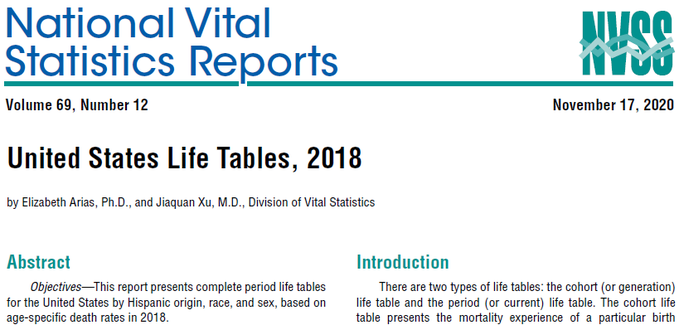Life Expectancy in the U.S., 1900-2018
Posted on byThis week, NCHS published the latest “life tables” for the United States, through the year 2018. Life expectancy estimates for 2019 are expected to be released in the coming weeks. The new report, “United States Life Tables 2018,” features a rich collection of historical data, extending back to the beginning of the 20th century, when life expectancy at birth in the U.S. was only 47.3 years (see Table 13). The tables in the report document how life expectancy for the total population has increased over time and is now 78.7 years for the U.S. as a whole.

Over the past 50 years, declines in life expectancy have been relatively rare. However, in the early part of the 20th century, life expectancy was quite volatile, declining 13 times between 1902 and 1928 – including a staggering 11.8 year decline in life expectancy during the height of the influenza pandemic of 1918, in which life expectancy at birth dropped from 50.9 years in 1917 to 39.1 years in 1918. As the pandemic subsided, life expectancy reversed course and increased 15.6 years in 1919 to 54.7 years.
This phenomenal two-year period illustrates that historically, declines in life expectancy can be usually traced to significant health events occurring nationally and globally. During the years of the Great Depression and World War II, for example, there were four years when life expectancy in the U.S. declined. In 1957, as the so-called “Asian Flu” began to take a foothold globally, life expectancy in the U.S. ticked down.
Most often, declines in life expectancy have been only one-year events, before resuming an upward trend. Remarkably, between 1924 and 2018, only once did life expectancy decline for two consecutive years – in 1962 and 1963. In 2015 and 2017, life expectancy at birth declined, but remained unchanged in 2016 and increased slightly in 2018.
Disparities in life expectancy at birth between racial groups have long existed, and continue today. Life expectancy is higher for non-Hispanic whites than for non-Hispanic blacks – a gap of 3.9 years in 2018 (see Table A). At the same time, life expectancy is higher for U.S. Hispanics than for non-Hispanic whites (a gap of 3.2 years). With age, these gaps start to narrow – at age 65 the gap in life expectancy between non-Hispanic whites and non-Hispanic blacks was 1.4 years in 2018, and the gap between Hispanics and non-Hispanic whites was 2.0 years. By age 75, the gap in life expectancy narrowed to 0.3 years between non-Hispanic whites and non-Hispanic blacks, and to 1.7 years between Hispanics and non-Hispanic whites. By age 79, the gap in life expectancy disappears between non-Hispanic whites and non-Hispanic blacks and by age 80, life expectancy is actually slightly higher for non-Hispanic blacks than non-Hispanic whites (9.2 years vs. 9.1 years). The gap in life expectancy between Hispanics and non-Hispanic whites and non-Hispanic blacks remains at least one year throughout the life tables.
Possible explanations for the gap in life expectancy and the reduction in the gap as people age includes the fact that death rates for external or “premature” causes of death are higher among younger non-Hispanic blacks vs. non-Hispanic whites and Hispanics, though there are no data in this particular report on possible reasons for the disparities. Other NCHS reports, however, do address causes of death that contribute to life expectancy.
Posted on by

